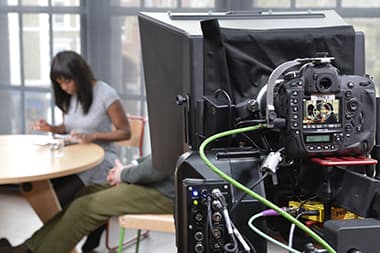VIDEO: AP goes behind the scenes at London Live’s studios in Kensington, speaking to the station’s technology director Bryn Balcombe and Nikon’s Professional Services and Business Solutions manager James Banfield
Four years ago the director of cult US TV series, House, said that DSLRs were the future of filmmaking.
Greg Yaitanes chose the Canon EOS 5D Mark II to shoot an episode of the hit show, in what was hailed as a first for the industry and reflected a growing market for high-quality movie recording in DSLRs.
At the time, Yaitanes praised the 21.1-million-pixel full-frame, Full HD, camera for its ease of use in ‘tight spaces’ and ‘richer shallow focus that pulls the actors faces to the foreground of the shot’.
The director used 24-70mm and 70-200mm zooms, plus Canon’s prime lenses, to achieve the look he was after.
When not handheld, Yaitanes used a small tripod.
‘Visual impact’
More recently, Canon’s EOS 5D Mark II and EOS 7D were chosen to shoot stunts and ‘close-quarter’ action work on the set of 2012 movie, ‘Marvel’s The Avengers‘.
Canon said filmmakers used them to ‘seamlessly intercut with footage from the film’s principal 35mm and digital cinematography cameras to heighten the film’s visual impact’.
The movie’s cinematographer Seamus McGarvey added: ‘They are great for shooting additional angles that give film editors more options for creating powerfully immersive and kaleidoscopic views of action scenes.’
In the same year, BBC cameraman Fred Scott deployed a 5D Mark II to shoot a film for Panorama called Homs: Journey into hell.
Fast forward to 2014, and if you believe a report in the February issue of Televisual, a trade magazine, the 5D’s ‘glory days are over’.
The magazine points out that the Canon 5D kicked off the DSLR video revolution, when it was used for ‘commercials, promos and even broadcast work’.
However, Dan Wheeler, managing director of PEC Video Ltd, which hires out camera gear, told the magazine: ‘Large sensor video cameras have taken over from DSLRs for customers wanting the large sensor look.’
Why then has a new TV station chosen Nikon D4 and D800 DSLRs for its live broadcasts?
Cost saving and shallow depth of field
A key part is cost, with a traditional TV camera costing upwards of £60-70,000 (including the price of broadcast lenses), according to Bryn Balcombe, technology director at London Live, a new 24-hour TV station built from scratch.

One of the two London Live studios that use Nikon D4 DSLRs to broadcast shows
It’s not just a money-saving exercise, though.
The broadcaster was after the shallow depth of field and a consistency normally associated with large, high-end, imaging sensors, says Nikon Professional Services and Business Solutions manager James Banfield.
Balcombe adds: ‘We wanted a completely different visual look, more akin to a post-production look… It’s important for us to make sure our studio output matches the quality of content that’s coming in, across our daily broadcast…’
London Live last week gave Amateur Photographer an exclusive guided tour of its two, brand new, studios – one used for current affairs programmes, the other for news bulletins – both housed in the offices of the London Evening Standard and Independent newspapers in Kensington.
Programme makers use D4s in the studio – they plan to upgrade to D4S models shortly – and D800s on location.
The D4 has direct Ethernet functionality, so it can be controlled over local computer networks, giving TV technicians more flexibility.
‘We don’t need that control out in the field, so that means the journalists get a smaller, lighter camera, but with the same visual quality,’ explains Balcombe.

James Banfield: ‘This is an incredibly exciting project for Nikon’
A variety of lenses are used. These include a 16-35mm for wide shots and a 70-200mm for ‘singles’ – allowing cameras to be used further away from presenters and guests.
Yellow brick road
The cameras are attached to HDMI to HD-SDI mini converters – dubbed ‘yellow bricks’ – that allow HDMI output to be synched with the broadcast system.
Meanwhile, a bespoke, nine-axis, robotic system has free reign over the studio, allowing the cameras to mimic almost any move an operator can make. The Mark Roberts Motion Control robotic arm is mounted on a rail that allows a camera to be moved across the entire length of the studio.
A single operator can control five cameras, plus one mounted on the robotic arm, all from inside the studio. Other cameras are fixed into the ceiling ‘grid’ or on a tripod.
Though live television shows have used Nikon DSLRs in the past, this is the first TV station to make Nikon DSLRs ‘the backbone of their live-to-air broadcast’, explains Banfield.
Help for budding filmmakers
Following a surge in requests for DSLRs for filmmaking – ‘across the industry’ – Nikon says it works with professional photographers and video-makers, to help them get the most from movie-enabled DSLRs.
Nikon also runs a basic DSLR filmmaking course at the Nikon School in central London.
‘More and more people are being more creative and it’s great to see this level of creativity coming from photographers and videographers… To them, it can sometimes be a foreign tool when they are used to a broadcast camera,’ adds Banfield.
London Live programmes are available on Freeview 8, Sky 117, Virgin 159 and YouView 8. They are also available to watch on the London Live website.
- Amateur Photographer (AP) is organising an introduction to filmmaking course at Pinewood Studios in Buckinghamshire on 9 June. Run in partnership with Canon and Tiffen, the course will tackle areas ranging from kit, to video editing and audio. A Canon EOS 70D will be awarded to the most impressive student. The course costs £199 and places are limited. For full details, keep an eye out for future issues of AP








